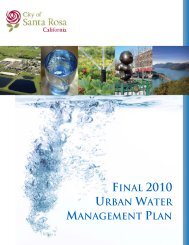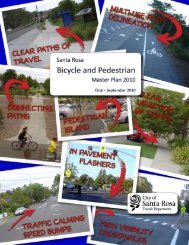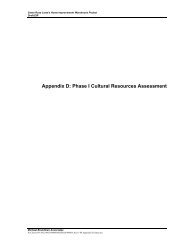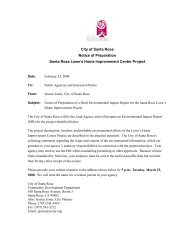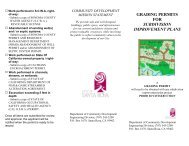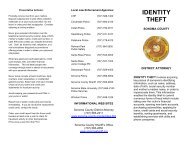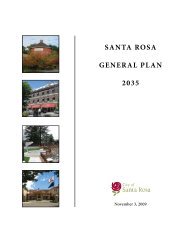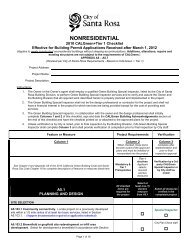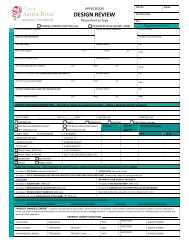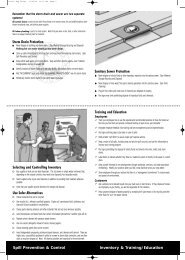Fountaingrove Environmental Impact Report - City of Santa Rosa ...
Fountaingrove Environmental Impact Report - City of Santa Rosa ...
Fountaingrove Environmental Impact Report - City of Santa Rosa ...
You also want an ePaper? Increase the reach of your titles
YUMPU automatically turns print PDFs into web optimized ePapers that Google loves.
2.0 LIST OF COMMENTERS AND RESPONSE TO COMMENTS<br />
identified in Table H-1 Special-Status Plant Species Potentially Occurring within the<br />
<strong>Fountaingrove</strong> Lodge Study Area in Appendix H to the Draft EIR. These two species<br />
are streamside daisy, which has a low potential <strong>of</strong> occurrence and blooms between<br />
July and September, and wooly-headed lessengia, which has a very low potential <strong>of</strong><br />
occurrence and blooms in mid- to late August. This correction is shown in<br />
Section 3.0, Errata and Revisions, <strong>of</strong> this Final EIR. Because the rare plant surveys<br />
were conducted over a period <strong>of</strong> 3 years, during early, mid-, and late season<br />
blooming periods; the wooly-headed lessengia and streamside daisy have,<br />
respectively, very low and low potential for occurrence; and the multiple focused<br />
rare plant surveys did not reveal the presence <strong>of</strong> any special-status plant species.<br />
Potential impacts to special-status plant species are considered to be less than<br />
significant, as noted in <strong>Impact</strong> 3.4-6. However, it is still possible that rare plant<br />
surveys may be required by the applicable resource agencies, including California<br />
Department <strong>of</strong> Fish and Game (CDFG) and U. S. Fish and Wildlife Service (USFWS),<br />
based on their review <strong>of</strong> the EIR and Rare Plant Survey <strong>Report</strong>, included as<br />
Appendix G to the Draft EIR.<br />
6) Table 3.4-3 indicates in table footnote “c” that olive trees do not require replacement<br />
under the <strong>City</strong> <strong>of</strong> <strong>Santa</strong> <strong>Rosa</strong> Tree Ordinance (<strong>City</strong> Code Chapter 17-24 Trees).<br />
Requirements for tree replanting are described in more detail in Mitigation<br />
Measure 3.4-1a <strong>of</strong> the Draft EIR and in Master Response Oak Trees and Oak<br />
Woodland <strong>of</strong> this Final EIR document.<br />
7) Comment noted. Requirements for tree replanting are described in more detail in<br />
Mitigation Measure 3.4-1a <strong>of</strong> the Draft EIR and in Master Response Oak Trees and<br />
Oak Woodland <strong>of</strong> this Final EIR document.<br />
8) The first bullet in Mitigation Measure 3.4-3 states that “[t]o avoid impacts to nesting<br />
avian species, Project activity shall be avoided to the degree feasible during the<br />
breeding season (generally, March 1 through September 15).” The specific dates <strong>of</strong><br />
the breeding season to avoid nesting avian species will be confirmed with the<br />
resource agencies.<br />
9) Section 3.6, Geology, Soils, and Seismicity has been amended on p. 3-68 as follows:<br />
“Investigation <strong>of</strong> Fault Surface Rupture Hazard, <strong>Fountaingrove</strong> Lodge, <strong>Santa</strong> <strong>Rosa</strong>,<br />
California (Giblin, 2007). This study included additional trenching excavation and<br />
logging to resolve discrepancy regarding a possible faulting through the northeast<br />
portion <strong>of</strong> the Project site.”<br />
10) Section 3.6.1, Setting, description <strong>of</strong> Topography and Drainage, has been amended<br />
on p. 3-69 as follows: “Local drainage features within the Project vicinity site include<br />
subdued drainage swales, closed or nearly closed drainage depressions, and abrupt<br />
changes in stream direction and gradients.”<br />
11) Section 3.6.1, Setting, description <strong>of</strong> Bedrock has been amended on p. 3-70 as follows:<br />
“Scattered test pits dug by Giblin Associates showed lava flow rocks, agglomerate,<br />
tuffaceous, and sedimentary rocks. Bedding observed indicated that the rocks in the<br />
central portion <strong>of</strong> the property are folded in an anticline (concave downward). Beds<br />
are gently folded with dips varying from gently eastward at the higher elevation in<br />
ES092008001PHX\BAO\082970001 2-23



